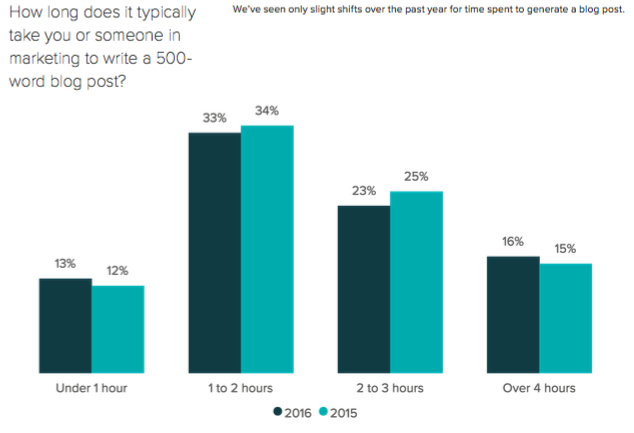For years, you’ve been hearing how important content is to your online marketing game plan. In 2016, over half of both B2B and B2C marketers are planning to increase their investments in content marketing. The challenge is overcoming the time and financial investment to create a meaningful volume of great content.
But creating content doesn't have to be as expensive as you think.
The following post explains why content is important to your online marketing playbook, and how you can more than double your content production with very little extra effort.

What is "content"?
Content takes on many shapes and forms. This includes blogs, eBooks, whitepapers, video, and images.
Why is content important?
Content is a highly versatile asset. It can be used to boost SEO, expose new people to your brand, convert users on landing pages, and nurture prospects through the buying funnel. SEO, email marketing, and social media all benefit from high quality, unique content. In many cases, great content is critical to success on these channels.
Why you want to repurpose your content:
With content playing such a major role in almost every online marketing channel, producing enough quality content to be competitive is difficult. Most small and medium businesses struggle with maintaining a single blog, let alone producing white papers, eBooks, and video.
According to the 2016 State of Inbound Report from Hubspot, a 500-word blog post takes several hours to produce. And in our experience, 500 words just doesn't cut it. Having written thousands of blogs over nearly a decade, we know length matters. That means in order to produce a blog that matters, you must invest AT LEAST 4 hours. This includes text, images, visuals, editing, and posting.

The solution is to repurpose your content. This simply means taking an existing piece of content and investing a little extra time to reformat it for a different channel. This allows you to produce the same volume as a company with an in-house content team, but on a much smaller budget.
Here are eight ways you can make more use out of your content.
-
Turn your blogs in an eBook
Pull together seven to ten blogs on a related subject, add an intro, conclusion, some segues, and package it into a single eBook. 95% of the eBook production time is already done via the blog. You’re simply stitching it all together.
To make the eBook visually appealing, visualize key data and any powerful quotes you want to highlight. Numbers, Excel, and even Google Sheets are good for simple graphs. For visuals, we're pretty obsessed with Canva. Piktochart is also effective for larger graphics.
-
Turn a whitepaper into multiple blogs
Here, we’re doing the same thing as #1, only in reverse. Break up the whitepaper chapters into individual posts then tweak the content to make it stand on its own.
-
Turn a video into a blog post w/ a manuscript
Take your video content, transcribe a manuscript, and add it to your blog (with the video) as an individual post. This may seem like a lazy way to meet a blog quota, but converting a video into a written format in friendly for both the search engines and website visitors unwilling to watch videos.
-
Turn a presentation into a blog post
Presentations are great sources of repurposed content. To do this, take key images from your powerpoint presentation, write out the accompanying script, and combine the two into a 1,000 word blog post.
-
Turn a Powerpoint presentation into slide deck
This requires very little time. Simply upload your powerpoint presentation to a site like Slideshare, tag the presentation with targeted keywords, and upload. Slideshare will often show in Google search results, so this is an easy way to get discovered. Make sure you brand every slide!
-
Turn a blog into evergreen content
Evergreen content is content which stays relevant over a long period of time - ideally years. If you only produce content based on news or statistics, your content will have a short shelf life.
To produce effective evergreen content, find an existing blog post on a timeless topic, and continue to revise and add more information to the post. Republish the post after each update.
-
Turn surveys into blog posts
Like white papers, surveys can be broken up into individual blog posts, each focused on an individual question or survey segment. Accompanying charts and graphs can then be used on social media.
-
Turn popular blogs into lead nurturing pieces
Email, as a channel for building 1:1 connections, is vastly underutilized. Instead of always trying to sell or generate clicks back to you site, create email blasts containing your highest value content. The entire post should reside within the body of the email. Your primary goal with this strategy is to get people to open the email and read your high value content. This establishes your company as a thought leader and provides value back to the market. It requires little, if any, extra content production.
Content allows brands to differentiate themselves and demonstrate their expertise, but it takes a meaningful investment of time and resources. Repurposing your content into new formats improves efficiency and allows small brands to act like big ones.
Ready, set, repurpose!





Agree, disagree, or just have something to add?
Leave a comment below.